|
by maistre Emrys Eustace, hight Broom |
|
IAmBroom @ yahoo . com |
|
Why We Wear Underclothing:
- Warmth
- Cleanliness (protect the outer, better garments from soiling)
- Erotic suggestion of undress (e.g., modern fads for eveningwear resembling
underclothing; Tudor chemises which peekaboo from bodices)
- Erotic shaping of the body (brassieres, corsets, foxtails, tightly fitting
men's hosen)
- Control (restriction of the breasts and male pouch)
- Decorum
Rarity of Evidence from Period
Medieval underclothing was generally covered by outerwear almost as thoroughly
as modern underclothing, but with a much lighter restriction on its display.
Thus, we do have illustrations of workers at hard labour wearing nothing more
than their "underclothes". Prisoners were displayed in their
underclothing as a debasement, so paintings depicting the execution of
contemporary notorious figures such as religious heretics and the Master of the
Knights Templar provide rare complete views of these garments.
We occasionally get glimpses of the edges of these garments, as during periods
when the undertunic peeks out from the sleeves or neckline of the outer wear, or
through the slits in the bottom hem of tunics, but it is difficult to glean much
more information than length out of these.
|
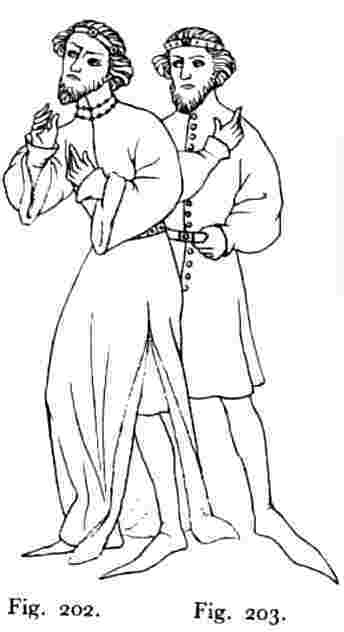
c1390. 2 courtiers or ducal uncles of Richard II. [Houston
p111]
|
|
Since the Medievals did not seem to attach much erotic importance to
underclothing, there are few "titillation" depictions of these, even
in religious allegories of damnation. Lovers in bed are invariably depicted
naked except for nightcaps. The damned in hell are typically portrayed either
nude (naked and defenseless), or wearing the excessively rich and vain clothes
for which they were condemned (exemplifying the mortal sin of vanitas).
|
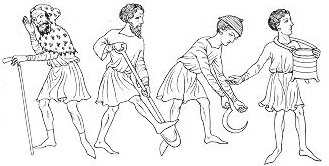
1200-25. Peasants, from psalter in British Museum. [Houston p51]
|
Be wary of interpretations based on single illustrations, or their
interpretations by others. The second figure in the drawing at right seems to be
a worker stomping a shovel into the ground barefoot (ouch!), and thus without
hosen; compare his figure with others beside him and it becomes less clear. He
is probably wearing both hosen and shoes; the modern rendering of this period
illustration does not make this obvious.
Materials
Linen was often chosen for comfort in garments worn next to the skin. It was
easy to bleach: laid in the sun wet, UV light will oxidize the water and bleach
the fabric (when laid out dry in UV, the plant fiber oxidizes instead, turning
it yellow). However, this was still a luxury item: sunning linen would occupy
scads of sunlit, flat, and presumably arable land.
Woolen undergarments appear in various references, which offered the sensibility
of additional warmth at the cost of comfort; thus, there are occasional
references to class distinctions, with the rich preferring linen underclothes.
There are also admonitions to wear sensible wool for undergarments, instead of
bowing to the (supposedly) unhealthy fashion to wear finer cloths.
Blended textiles were very common (e.g., fustian is sometimes described as a
wool/silk blend), and might have made a pleasant compromise in warmth and
comfort. Linen/wool underclothing is therefore believable, although I have never
heard evidence of such. There are also references to linen linings for wool
hosen.
Silk was tremendously costly, and, as today, was rarely used for garments which
were not meant to be seen (modern erotic underwear does not meet this
criterion). For hosen, however, there are some rare references to its use. Henry
VIII ordered silk hosen to be made for his sister.
Cotton was probably not used at this time for underclothes. Although imported to
Europe by at least the 13th c (from India and Arabia), it seems to have been
prohibitively expensive. It is frankly poorly suited to these uses: it shrinks
tremendously in washing, and continues to shrink, making it poorly suited to
tightly fitted hosen (wool fibers stretch and relax back to near original size);
it retains moisture, making it a poor insulator and a good rotter; it weakens
when wet; it stains easily. Bear in mind when reading sources from our period
that until the 18th c the term "cotton" or "coton" could
refer to any of: wool fiber, cotton (plant) fiber, or various specific cloths
made of wool or cotton or both.
Knitting is almost never mentioned in the manufacture of any garments except
headgear, prior to the 16th c. Queen Elizabeth received a gift of knitted hosen
from Spain, which quickly became the height of fashion for the well-to-do; the
implication is that knitted hosen were unknown in England prior to this, and her
father wore hosen cut of broadcloth.
An exception of which I am aware: there are depictions of the Madonna knitting
what appears to be a shirt for the Christ child. As always with religious
pictures, one must be very cautious in the interpretation of what is depicted.
What appears to be supportive evidence that knitted underclothing was worn by
babies, it is far more likely a symbolic biblical reference:
John 19:23. The soldiers therefore, when they had crucified Jesus, took his
garments and made four parts, to every soldier a part; and also the coat: now
the coat was without seam, woven from the top throughout.
Thus, this may be merely a Medieval interpretation of how such a coat could be
constructed; this is not proof that such garments were ever made.
From a post to H-Costume by Dawn T. Jacobson, dated 14 Oct 95:
"Although it appears that knitted caps were becoming more commonplace by
the late 16th Century, it appears that knitted hose did not catch on until well
into ERI's reign (the 1570s). Stockings had to be imported from Italy or Spain,
and were very expensive. In 1566, the first mechanized wireworks was built in
England, supplying a source of good steel knitting needles in small enough sizes
to allow the knitting of hose. An example of the fineness of the work are the
silk stockings found in the grave of Johan III, buried in Uppsala in 1592. The
stockings, made much as stockings are made today, knitted in stockinette stitch
with a single purl down the back to serve as a seam, started with 254 stitches
cast on. By comparison, a stocking I'm presently knitting on #1 pins started
with only 1/2 that many stitches cast on. By my estimate (Rutt did not provide a
gauge for Johan III's stockings), they are 18-20 stitches to the inch.
In the 16th c., German references mention the use of knitting to make berets,
hats, and stockings (according to a post to H-Costume by Julie Adams dated Mon,
9 Oct 95 [Textilier Hausrat]). Apparently, the English were far behind the
Germans and Spaniards in this regard. One member of H-Costume offered a
plausible excuse for why it took so long before Europeans, who knew how to knit
in various forms throughout the Medieval period, used it for hosen. After all,
knitted items are extremely springy, waste no thread, and can form seamlessly
fitted hosen; knitting seems ideally suited for hosen. However, she explained
that in the time that it took her to knit one inch of a leg-sized tube, she
could weave one foot of woolen cloth.
Loincloths / Trewes / Breeches / Braies / Bracchæ
Men
Usually not intended to be normally seen, these seem to be universally white or
unbleached in the Medieval period. (Please contact me immediately if you find
other evidence!)
The braies were cinched at the waist with a running cord or girdle which laced
in & out of the rolled hemline. The hosen were originally tied to this
(until the late 14th or early 15th c.). Additionally, the purse could be tied to
this cord, and thus kept under the tunic, out of harm's way. Slits in long
tunics allowed access to the purse without "hoisting the mainsail."
A consistent feature of depictions of Medieval braies is a wide, baggy bunching
at the waistband, as though lots of fabric were being gathered. Having worn an
attempt at such for some time now, trussing my hosen from the front & sides
of the running cord (which I made from simply a bias-cut strip of broadcloth), I
can attest that thin cords bite into the waist over the day, especially when
cinched tightly enough to support the hose (and I haven't even added a purse
full of silver!). Additionally, such cords in period depictions appear quite
wide themselves, although an expected large knot is not apparent. Wider cloth
strips would certainly spread out the stress; but I am less sure of this because
of the absence of large knots.
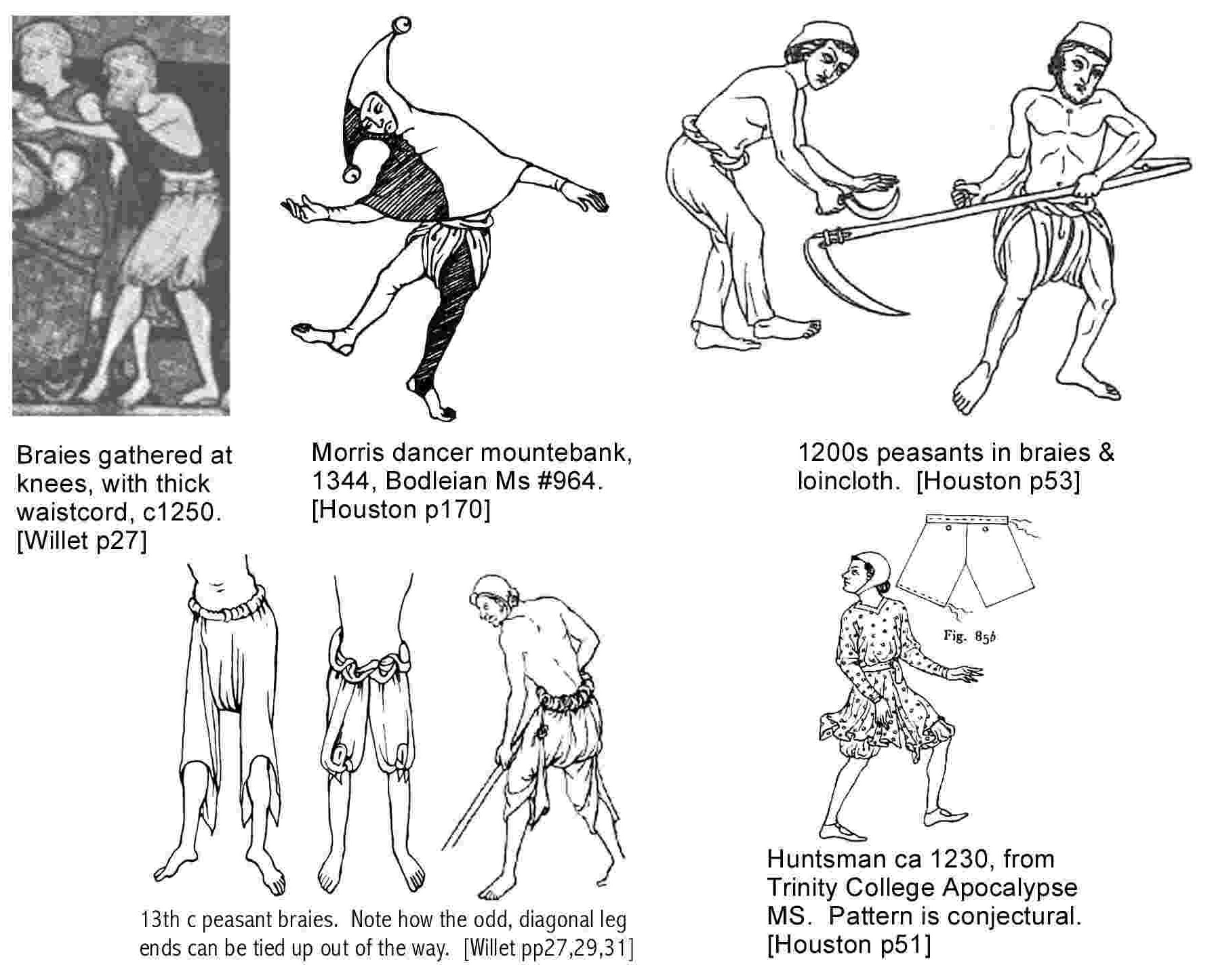 |

c1430-40 Stealing a judge's britches. Tarrant p53
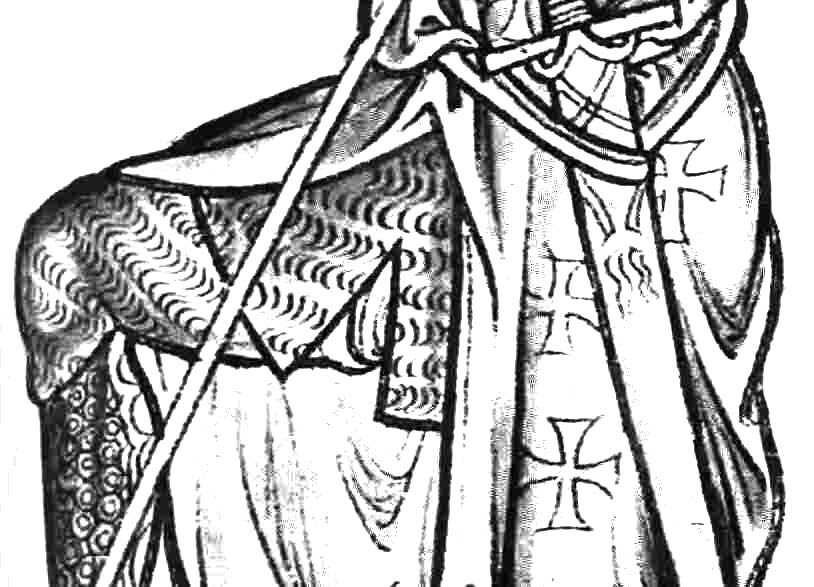
1200s Crusader trewes peeking between mail legs. Laver p56
|
Lady Kate Oakley (Val Winkler) suggested to me the pattern similar to the one
at right, which is based on 13th c braies. In the 13th c, of course, tunics were
longer, and the hose could stop at the knees, so the braies might have been made
of two leg rectangles, instead of a single rectangle at the waist. This pattern
would allow short braies to be worn in the high-hosen period of the late 14th c,
without major modification of an existing pattern.
|
When the hosen began to be affixed by points to the under-cotehardie or
pourpoint, the design requirements shifted for the breeches. (I will use this
newer word to distinguish them from the previous form, although it is not a
historical distinction. Bear in mind that the words we use to differentiate
clothing types are often modern distinctions, or merely linguistic trends - such
as from 'braccae' to 'braies' to 'breeches' - that did not indicate a specific
difference in period.) They were now visible more often than not, and a baggy
pair of breeches just would not do on the silhouette of a buffed-out 15th c
courtier. The pattern above would work for a brief period (no pun intended), but
by the time the Lancastrian men of the early 1400's were showing off their full
buttocks in joined hosen, the "breech" part of the hosen would require
a cut more closely resembling modern men's pants (with a J-shaped fork pattern).
Actual breeches may have followed suit, at least amongst the middle-class, since
skilled tradesmen of this era seem be wearing quite snugly tailored breeches. I
presume that the high-fashion joined hosen of this time were worn without
breeches beneath them, to produce the smooth flattering curves depicted in the
paintings.
|
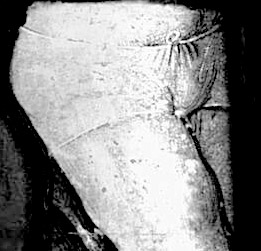
1490 Toledo Museum
|
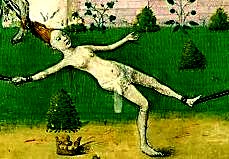 The breeches no longer needed a cinch cord to snake in & out of the hem, so
the hem fully enclosed the cord. Wrapping around more than a full circle of the
waistline and overlapping in front, the ends were pulled back together,
gathering the front center. In this way, the breeches could be well-fitted
behind, while there was enough give when open to make them easy to don. This
also created the pouch seen in most 15th c depictions of men stripped to their
underclothes. In fact, statues of the crucifixion provide an excellent chance to
study the 3-D form of (sometimes) realistic underclothes. Don't miss the chance
at your next museum visit! To the right is image from Boccaccio, ca 1475, of a
woman prisoner wearing trewes.
The breeches no longer needed a cinch cord to snake in & out of the hem, so
the hem fully enclosed the cord. Wrapping around more than a full circle of the
waistline and overlapping in front, the ends were pulled back together,
gathering the front center. In this way, the breeches could be well-fitted
behind, while there was enough give when open to make them easy to don. This
also created the pouch seen in most 15th c depictions of men stripped to their
underclothes. In fact, statues of the crucifixion provide an excellent chance to
study the 3-D form of (sometimes) realistic underclothes. Don't miss the chance
at your next museum visit! To the right is image from Boccaccio, ca 1475, of a
woman prisoner wearing trewes.
The pouch simultaneously hid, and called attention to, the package beneath.
Although the breeches are now visible, they are still universally white or
undyed (in my experience).
Women
|
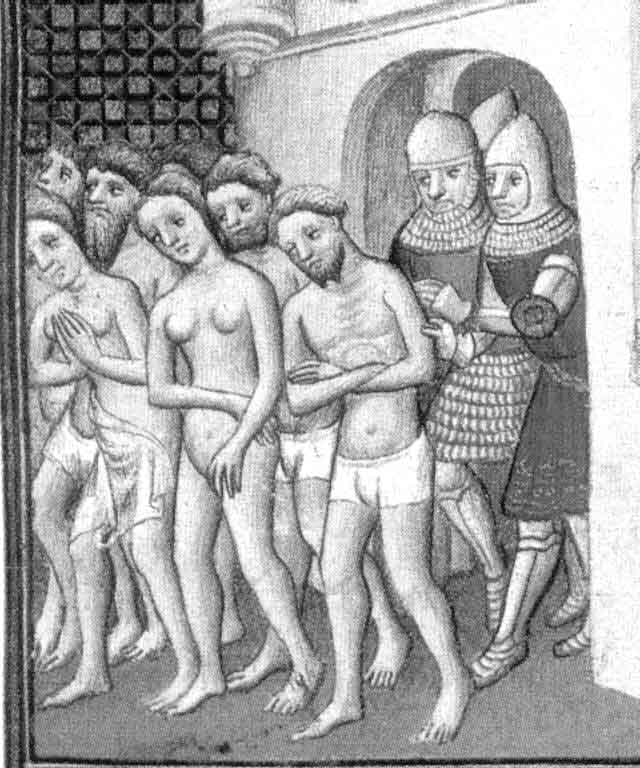
15c. Hallam (P Encycl)
|
The month of February in Le Duc de Berry's Très Riches Heures
shows a well-known, humorous depiction of a worker woman warming her
legs & privates before a fire, her dress hiked up to her waist. This
pornographic detail of a Medieval prayer book provides a rare look under
the skirts of our period. Notably, the man is wearing hosen that end in
a band just below the knees; since it is winter, his tunics will all be
long, and there's no need for him to wear the high hosen that go with
his warm weather attire. A picture in Knives & Scabbards shows a
couple in flagrant delecto in front of a knifeseller's stand; the woman
wears only calf-high hosen, but no 'panties'
|

1412-6 Tres Riches Heures - February
|
Normally, underpants would seem to be an inconvenience, as long underskirts
provide much easier access for the toilet, are warm (when they reach to the
ground), and are easier to make. Of course, menstruation produces a different
incentive. The rags of old would need to be retained by some sort of trewes, or
at the least a loincloth. Arguably, this could be a spare pair of her husband's borrowed for the occasion, although given pervasive and antiquated views on the
moral 'cleanliness' of women during periods, it seems less likely. Perhap along
with her personal rags, each woman kept an old pair of trewes for this use.
borrowed for the occasion, although given pervasive and antiquated views on the
moral 'cleanliness' of women during periods, it seems less likely. Perhap along
with her personal rags, each woman kept an old pair of trewes for this use.
Children
After the age of swaddling, and before the children began adolescence, what
evidence I have seen suggests children went without underclothing. There is an
anecdotal reference to mothers walking young boys just outside the threshold to
pee, and also planting lettuce there (which loves frequent waterings!).
Obviously, this simplifies potty-training accidents. There are cartoons of
whipped schoolboys and tree-climbing lads, showing bare bums beneath their
tunics, as in this image from Bodleian c1445.
Coifs and Hoods Used as Coifs
Coifs, made of linen or silk, provide both warmth and protection for more
expensive (and less washable) headgear from hair oil. They also offer immunity
from "hat hair"!
|

c1340. Luttrell Psalter. Note
'under-hood' & late use of cross-garters. Houston p 103
|
I do not know when they first came into use, but they were immensely popular in
England in the 13th c., and by the 14th c had lost favor, their use retained
mostly by lawyers, according to [Houston p84]. However, this seems not to have
been the case abroad, as shown in [Houston 116] of an Italian merchant from the
late 14th c., who wears a coif under his chaperone (worn here as a hat). In
every instance I have seen, including padded ones for arming, the coifs are
white. They are tied beneath the chin with a single cord, which emanated from
flaps over the ears, and typically the cord slopes forward at a diagonal angle
to the chin. This angle is what keeps the coif secure from shifting forward in a
helmet (from a personal, unpleasant experience).
As an alternative, the liripipe hood, or chaperone, was occasionally worn under
hats, as depicted in the Luttrell Psalter, mid-14th c [Houston p103]. These
hoods with short "nubbins" of liripipes are someitmes referred to as
"capucin" hoods, after the monks, and they develop for dandies into
the cloth-wasting, longer liripipes. Worn this way, the purpose of the hood
seems to be to warm the head, and to protect the hat from hair oils. The hat
might only be worn here to keep the sun out of his eyes. Since the picture is of
a labourer, we may assume the combination is not merely for fashion's sake; and
thus the hood is being worn de facto as underclothing, just as the coif would
have been in the previous century. I presume this garment was always made of
wool or wool blends, to provide springiness in the tightly-fitted face opening.
This springiness allowed the rolled face opening to be used as a hatband when
the chaperone was converted (again, late 14th c.) from a hood to a hat, as in
the figure of the Italian merchant above. Finds of these hoods in London and
elsewhere show a row of small buttons which help fit the hood tightly under the
chin.
|
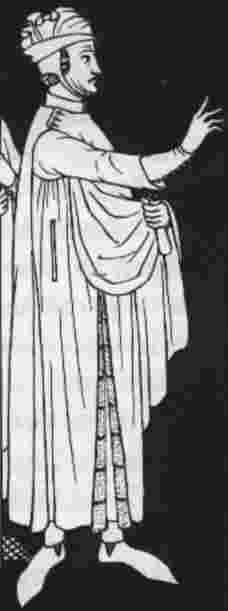
1375-00 Italian merchant. Houston p116
|
Finally, I note that almost all depictions of Medievals in bed show them wearing
nightcaps, and nothing else.
Shirts / Sherts
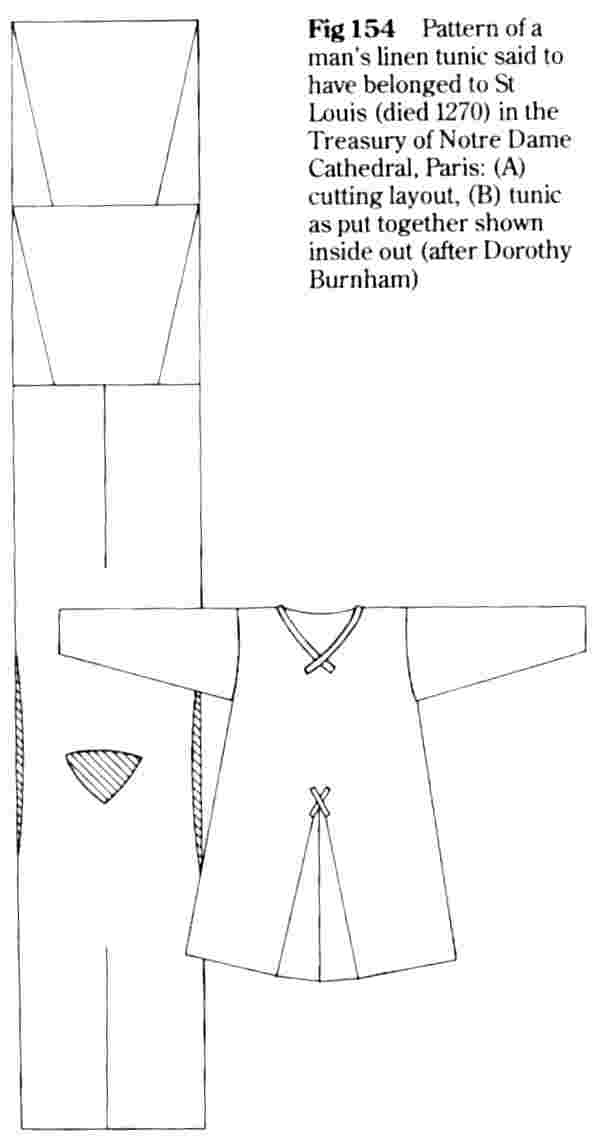 Although often completely hidden by outer garments, its necessity in this age
before hot baths, cheap soap, and washing machines is obvious to anyone who has
worn a wool suit jacket. There are occasional glimpses of coloured and even
embroidered undersleeves poking out from cuffs; however, bearing in mind that
this would probably be the most-washed garment on the body, I find it highly
unlikely that these are glimpses of the undermost shirt. It is possible that
these are sometimes faux-sleeves.
Although often completely hidden by outer garments, its necessity in this age
before hot baths, cheap soap, and washing machines is obvious to anyone who has
worn a wool suit jacket. There are occasional glimpses of coloured and even
embroidered undersleeves poking out from cuffs; however, bearing in mind that
this would probably be the most-washed garment on the body, I find it highly
unlikely that these are glimpses of the undermost shirt. It is possible that
these are sometimes faux-sleeves.
Fashion is conservative, usually differing more in minor hem length and
tailoring than in actual innovation, even between generations. The garment in
question here was not even meant to be seen by anyone beyond the immediate
household. When the outer tunics are being cut with rectangular sleeves + square
gores, it is a sure bet that the underwear is no fancier. But what about during
the cotehardie craze (c 1350-1450), when 'Cut Was King'? Wouldn't a square-cut
sleeve produce unsightly bunching, when milady was tightly laced into her
sensuously-curved cotehardie top?
The cost of a tailored sleeve is two-fold: tailoring time and wasted material. A
T-tunic can be cut without any waste at all. The burial shirt of Saint Louis
shows that scraps cut from the neckhole were cleverly fashioned into neckline
facing and gores for the armscye (the armpit region of the sleeve).
Personal experience in the SCA shows that underneath most lined cotehardies,
armscye bunching does not show through. Under heavy fabric (velvet, heavy
jacquards, fustian, etc), this would certainly be true. Relatively square
sleeves and body patterns were de rigueur in the previous century, and were
haute couture in the poofy-shirt era of the next century.
|
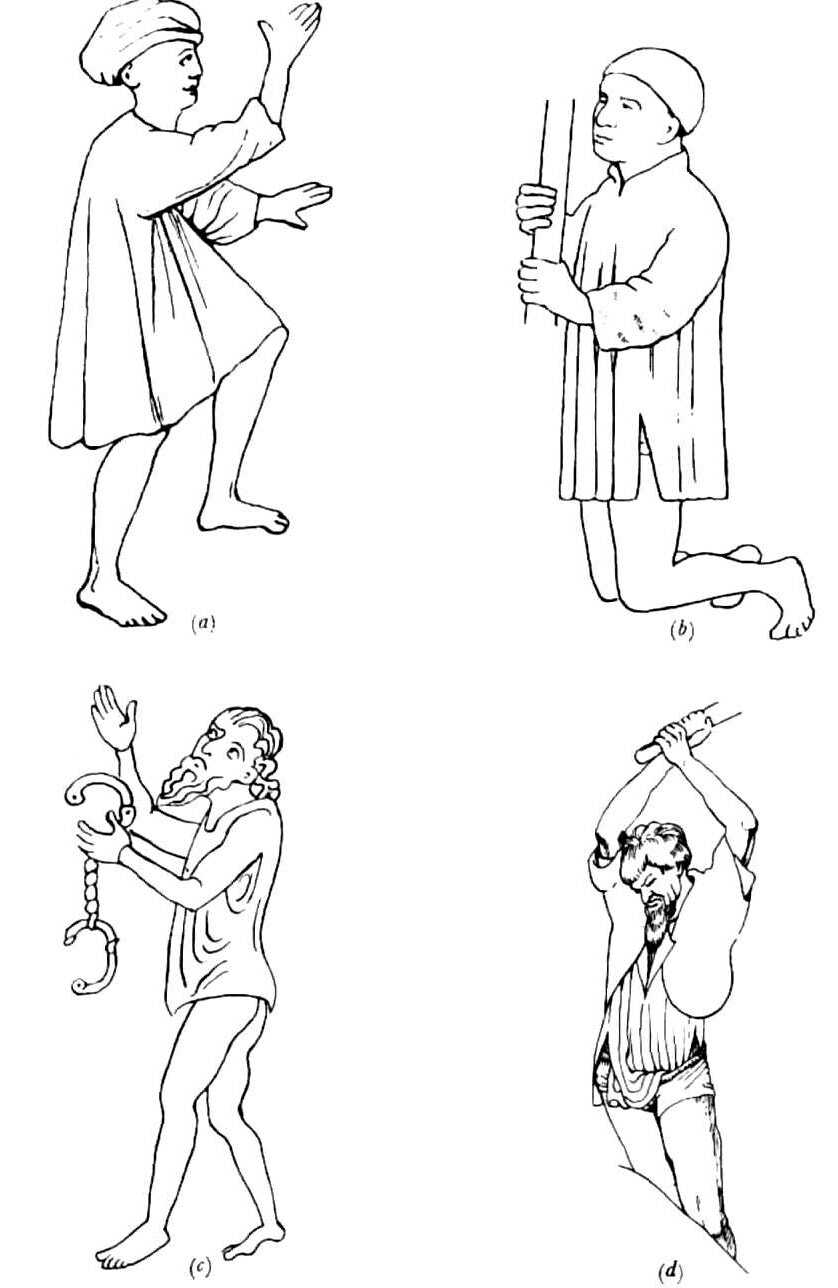
1400-1599 Shirts. Willet p24
|
The shirt never needs to be so well tailored in the chest that it would require
lacing or buttoning, nor have I ever seen a depiction of such a medieval shirt.
A simple linen shirt, spreading out comfortably from the mid-point of the
armscye, can be worn with a simple lace or button at the throat to close the
collar. In order to protect high outer collars from sweat, a courtier would need
a shirt that had a collar as well (although it might be a simple standing
collar). If any mere shirts did have a button closure, the buttons were most
likely handmade fabric ball-buttons. This is an age where a gift of some pins
was the romantic equivalent of a bouquet of flowers; metal was not cheap, and
neither were horn buttons.
|
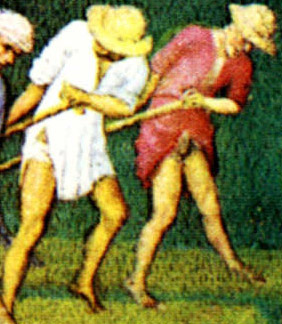
1412-6 Tres Riches Heures - June
|
 The shirt appears to show at the cuff and hems of 11th through 13th c garments,
even for the well-to-do. Sometime after this, it appears to be banished from the
view of polite society until the Renaissance. There is still some argument for
men's shirts retaining enough length to cover the crotch, even after outer
hemlines rose. A crotch-length tunic is far warmer in the privy and while
dressing, and it is at these moments (experience shows) that every bit counts.
It's a simple matter to hike a longer shirt up underneath a fitted cotehardie,
out of sight. In fact, as the painting of the execution to the right reveals (from an
edition of Froissart's Chronicles, c1425), both generous sleeves and long hems
could be hidden beneath tightly tailored clothing.
The shirt appears to show at the cuff and hems of 11th through 13th c garments,
even for the well-to-do. Sometime after this, it appears to be banished from the
view of polite society until the Renaissance. There is still some argument for
men's shirts retaining enough length to cover the crotch, even after outer
hemlines rose. A crotch-length tunic is far warmer in the privy and while
dressing, and it is at these moments (experience shows) that every bit counts.
It's a simple matter to hike a longer shirt up underneath a fitted cotehardie,
out of sight. In fact, as the painting of the execution to the right reveals (from an
edition of Froissart's Chronicles, c1425), both generous sleeves and long hems
could be hidden beneath tightly tailored clothing.
Padded, Doubled, & Fitted Undertunics: Gypons/Jupons/Paltocks/Gambesons/Doublets
As mentioned in the previous section on Hosen, in the late 14th c the hemlines
rose so high that it was necessary to tie them to an outer garment. This
temporarily relieved tailors of the problem presented by fitting garments over
the seat; hosen tied to a shirt had more room to move and stretch (from the
shoulders) than if they were still tied to the waist. It also provided surer
modesty and warmth, since it ensured there would be no gapping at the waistline.
By the 15th c, this garment had migrated from under- to outer wear.
A simple shirt would not hold up to the daily tugging of points from a pair of
hosen. The undertunic, which had become fitted along the lines of the cotehardie,
was rugged enough for the task, and was outfitted with 4-6 or more pairs of
holes through which the points of the hosen were passed & tied. As mentioned
earlier, a medieval technique for making strong holes in fabric was to spread
the threads out from a single "gap" in the weave with radial
buttonstitches; thus, the fabric is never cut. It is reasonable to assume this
buttonhole technique was also used here, to pass braided cords through.
Supposedly, this garment became heavily padded in the chest during the last
decade of the 14th c, producing the "pigeon-breasted" apearance of
young dandies seen in illustrations of King Richard II's court. I have been
unable to conclusively verify this super-padding. In civilian garments; it may
merely be an artistic convention, like the demi-grapefruit breasts which
mysteriously grew from the chests of virgins in this period. On the other hand,
this huge chest effect of young dandies continues into the Lancastrian regime,
with seam details that were missing in most of these Richard II-era depictions.
The corresponding military garment, the gambeson, was certainly padded. The very
word "gambeson" comes from the Anglo-Norman French word gambeisé,
"quilted".
Women's Underdresses
|
Women's underdresses begin as loose-fitting shirts or chemises, probably cut
simply to a T-tunic shape (i.e., without gussets). In the 12th & 13th c we
see the loose, flowing bliauts bound just beneath the breasts with wide belts.
The usual interpretation is that this "high-waisting" caused the dress
to billow out over the belly, suggesting continual pregnancy and thus fertility.
To appreciate this, we must free ourselves from the rather recent notion that
"Thin Is In", and remember that the goal of any married couple was to
have enough children to overcome infant (and maternal) mortality, with enough
progeny to carry out the family chores. Men often remarried multiple times, in
an age when divorce was unheard of. However, there may be one more practical
reason for high-belting which I have never heard discussed. Underneath that
freely-flowing bliaut was loose-fitting chemise, and under that, bare skin.
Belting beneath the bosom cinched the breasts in place, providing support in a
day when there was nothing yet resembling a brassiere to support the weight.
13th c undersleeves scoop out of the external sleeves to envelope the hands of
wealthy women. This serves a double purpose, to emphasize the class distinction
from those who labour with their hands, and to protect costly embroidered sleeve
cuffs from grease and grime. Clean, bleached linen cuffs could be easily
replaced by the wealthy, recycled into lesser uses.
|
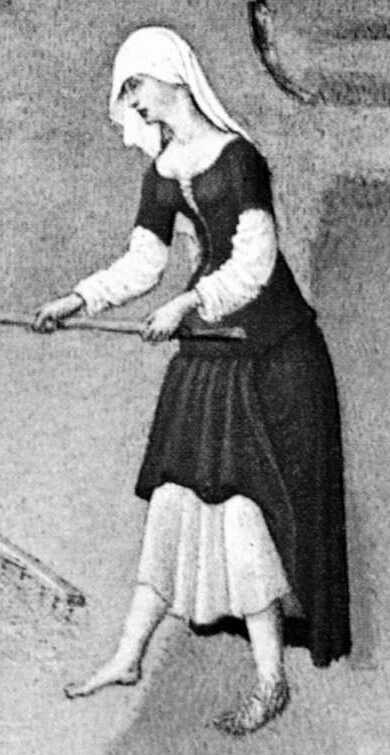
1412-16 Tres Riches Heures - June
|
By the 14th c they began wearing an under-cotehardie beneath the visible
cotehardie; i.e., an undergarment became more highly fitted so as to not produce
unsightly wrinkles in the sexy form of the tight cotehardies. Modern reenactors
(of both sexes) can attest to how readily a fitted cotehardie of cotton or linen
reveals bulges from underlying modern underwear. "Panty lines" from
bulky underclothes which today are mildly unfashionable might have been
unthinkably vulgar to a Medieval woman. This garment is not necessarily the
innermost layer, by the previous arguments in the Shirt section. Instead, they
might have been wearing a shirt of fine cloth, covered by a smoothing under-cotehardie,
and finally an outer garment; in the manner of modern panties (for comfort &
cleanliness), a slip (for smoothing), and a skirt (for show).
By the end of the 14th c we begin to see evidence of an underdress made of fine
or sheer cloth peeking out of the bustlines and sleeves. Another glimpse of
these delicate underdresses is found in depictions of nursing mothers, as with
the Madonna (1453-4) by Jean Fouquet, where the underdress is almost sheer.
Pictures of bathhouse attendant women appear in the Wenceslas Bible, made in
Bohemia c1390-1400. These women were regarded in their day as being of dubious
moral nature, or perhaps outright prostitutes, and are presumed to be dressed in
contemporary underclothes (a rare Medieval instance of eroticizing
underclothing).
Mistress Tangwystyl verch Morgant Glasvryn (Heather Rose Jones) describes these
pictures in a post to H-Costume dated 15 Feb 1996:
 "There is a whole set of
pictures from this manuscript depicting
bath-house attendants going about their work. Looking at the garments as a set,
what we appear to have is a garment that is relatively tight (but not fitted) in
the torso, flaring to a calf-length skirt. The top looks basically like a
"tube-top" (but of woven fabric) with what today would be called
spaghetti-straps. In some cases, the fabric is portrayed as sheer enough that
you can see the woman's body through it. Often there is a sash at the waist.
(Blue seems to have been a favorite color for this.) Other evidence in the
manuscript suggests that this garment is simply an ordinary undergarment. In the
illustration depicting the birth of Samson (f. 34), his mother is depicted as
wearing an identical-looking garment in childbed. I don't think that there is
any need to interpret the garment as boned or stiffened in any way. If the
ladies wearing them in the pictures look ... well... "firm" might be a
delicate way of putting it, I think we have to understand that these
illustrations were probably meant as erotica, and that young ... um ...
sprightly bodies were portrayed.
"There is a whole set of
pictures from this manuscript depicting
bath-house attendants going about their work. Looking at the garments as a set,
what we appear to have is a garment that is relatively tight (but not fitted) in
the torso, flaring to a calf-length skirt. The top looks basically like a
"tube-top" (but of woven fabric) with what today would be called
spaghetti-straps. In some cases, the fabric is portrayed as sheer enough that
you can see the woman's body through it. Often there is a sash at the waist.
(Blue seems to have been a favorite color for this.) Other evidence in the
manuscript suggests that this garment is simply an ordinary undergarment. In the
illustration depicting the birth of Samson (f. 34), his mother is depicted as
wearing an identical-looking garment in childbed. I don't think that there is
any need to interpret the garment as boned or stiffened in any way. If the
ladies wearing them in the pictures look ... well... "firm" might be a
delicate way of putting it, I think we have to understand that these
illustrations were probably meant as erotica, and that young ... um ...
sprightly bodies were portrayed.
Later, on Sat, 17 Feb 1996, she wrote:
"My general point is that the Wenceslas Bible has a very large number of
portrayals of variations of this particular garment. It's an astoundingly rich
resource for the dress of a particular occupation in a particular time and
place. And one of the delightful things about the collection of illustrations is
that there is a fair amount of variation in the details of what is clearly the
same basic garment. The fabric ranges from sheer to opaque; the skirts vary in
fullness; the straps may be present or not, and if present range from about an
inch and a half wide to extremely narrow (ca. ½ inch); the straps, if present,
may appear to be the same fabric as the dress or may be in a contrasting fabric;
if the latter, there is usually a band of the same contrasting fabric along the
top edge of the dress; one shows both these items and the hem decorated with a
design of lines and dots; one illustration clearly shows a center front seam,
most give no indication of seam lines at all; most are worn with a sash tied as
a belt, but some are worn with nothing belt-like.
"Another source, the Jena Codex, shows yet another variation on the style -
also from Bohemia, possibly from slightly later (I haven't been able to track
down the date of the manuscript). Here, the contrasting strap and band style
appears but with the body of the dress clearly gathered into the upper band.
Corsets / Bodices / Pair of Bodies
We will deal only briefly with this topic, as it is probably entirely
post-Medieval. Janet Arnold, the renowned expert on Elizabethan clothing,
proposes that the earliest remaining corset in England is from Queen Elizabeth's
effigy in Westminster Abbey. Evidence exists for corseting as early as the
beginning of the 16th c Various authors have explored the possibility that the
narrow, stylized female torsos of the 15th c were the resulting of corseting;
most conclude that if any restriction was used it was achieved by tight-lacing
cotehardies.
Bumrolls
Believe it or not, there is at least one piece of evidence that this
"figure aid" is Medieval. There is a diatribe by an English bishop
against women who wear foxtails beneath their cotehardies, supplementing what
Nature gave them!
|

1453-4. Jean Fouquet, from the Melun Diptych. |
Bibliography
Textiler Hausrat, Kleidung und Haustextilien in Nürnberg von 1500 -1650,
Deutscher Kunstverlag publisher, 1990.
Anderson , Ruth M. Hispanic Costume 1480 - 1530. ISBN 87535-126-3
Arnold, Janet. Patterns of Fashion - The Cut and Construction of Clothes for Men
and Women c 1560-1620.
Arnold, Janet. Queen Elizabeth's Closet Revealed.
Boucher, François. 20,000 Years of Fashion. The History of Costume and Personal
Adornment (Expanded Edition). (Harry N. Abrams, Inc., NY 1983). ISBN
0-8109-1693-2.
Crowfoot, Elisabeth; Frances Pritchard, and Kay Staniland. Textiles and
Clothing, c.1150-c.1450. (Medieval Finds from Excavations in London: 4) (alias
"T&C") (London: HMSO, 1992).
Kohler, Karl. A History of Costume. ISBN 0-4862-1030-8.
Hallam, Elizabeth, Ed. The Plantagenet Encyclopedia. (Grove Weidenfeld, NY 1990,
ISBN 01-8021-1289-7)
Houston, Mary G. Medieval Costume in England and France, The 13th, 14th and 15th
Centuries (Dover Publications, NY, 1996; 1st pub. Adam & Charles Black,
London, 1939, as Vol. II of "A Technical History of Costume")
Kybalova, Herbenova & Lamarova. The Pictorial Encyclopedia of Fashion.
Laver, James. Costume & Fashion: A Concise History. (Thames and Hudson, NY
1985, ISBN 0-500-20190-0)
Nockert, Margareta. "The Bocksten Man's Costume", Textile
History, 18
(2), 1987
Plantagenet Encyclopedia, British Library MS Cotton Nero E II pt2 f20v.
Rutt, Richard. A History of Hand Knitting (Interweave Press, ISBN 0-934026-35-1)
Sronkova, Olga. Gothic Woman's Fashion. (Prague, 1954)
Tarrant, Naomi. The Development of Costume. (National Museums of Scotland,
Edinburgh, w/ Routledge, London, 1994)
Waugh, Norah. Corsets and Crinolines. (Routledge, Theatre Art Books, NY, 1995;
1st publ. Theatre Art Books, NY, 1954)
Waugh, Norah. The Cut of Men's Clothes, 1600-1900. (Routledge, Theatre Art
Books, NY; 1st publ. Theatre Art Books, GB, 1964)
Willett, c & Cunnington, Phillis. The History of Underclothes. (Dover
Publications, 1992; 1st publ. Michael Joseph Ltd., London 1951)
Webliography
Bibliothèque Nationale de France. One of the greatest repositories of medieval
images for research purposes, as evidenced by nearly every costume book I've
ever opened. Also, a very friendly institution to deal with; I thank them for
permission to freely use their images for non-commercial educational purposes.
The website, unfortunately, does not yet carry as much content as the Bodleian. http://www.bnf.fr/bnfgb.htm
1,000 Illuminations from the Department of Manuscripts (pages in English): http://www.bnf.fr/enluminures/aaccueil.shtm
The execution picture was found at: http://www.siue.edu/chaucer/14thcent
Bodleian Library, Oxford University. The Bodleian site contains several of its
manuscripts in high resolution, full-page images. Be sure of which page of which
manuscript you want, as the images behind the microscopic thumbnails are often 3
Mb. However, the grain of the pages can almost be seen in the shots! http://www.bodley.ox.ac.uk/dept/scwmss/wmss/medieval/browse.htm#11th.
Schoolboy whipped by teacher (small size): http://www.bodley.ox.ac.uk/imacat/img0003.jpg
Bohemian Bath House Babes (Wenceslas Bible). http://www.idyllmtn.com/savaskan/bathhouse_babes.html
If anyone finds a source for more pictures than this one, please let me know!
Carlson, I. Marc (Diarmaid O'Duinn / Diarmuit Ui Dhuinn). Footwear of the Middle
Ages. Copyright 1999. I cannot too strongly recommend his websites on period clothing finds, shoes,
and related commentaries. http://www.geocities.com/athens/parthenon/5923/cloth/bockhome.html.
Duc de Berry's Très Riches Heures, http://humanities.uchicago.edu/images/heures/heures.html
H-Costume (Historic Costuming List). A highly informed list of worldwide
historical costume enthusiasts, with topics ranging from prehistoric clothing
finds to 1970's disco wear. Some warnings:
The digest version alone can be 20kb per day.
Some on the list are openly snobbish towards the SCA; however, they are still
eager to help.
The list, like most costuming material, is quite flammable.
To subscribe, send email to majordomo@indra.com, and in the body of the message,
put "subscribe h-costume" or "subscribe h-costume-digest".
Phebes, Gaston. The Hunting Book. http://www.bnf.fr/enluminures/texte/atx3_03.htm
An SCA recreation of ca 1265 braies, by Andy Goddard (Copyright 1997). http://www.bumply.com/Medieval/braies.htm

Return to the Greydragon library





 The breeches no longer needed a cinch cord to snake in & out of the hem, so
the hem fully enclosed the cord. Wrapping around more than a full circle of the
waistline and overlapping in front, the ends were pulled back together,
gathering the front center. In this way, the breeches could be well-fitted
behind, while there was enough give when open to make them easy to don. This
also created the pouch seen in most 15th c depictions of men stripped to their
underclothes. In fact, statues of the crucifixion provide an excellent chance to
study the 3-D form of (sometimes) realistic underclothes. Don't miss the chance
at your next museum visit! To the right is image from Boccaccio, ca 1475, of a
woman prisoner wearing trewes.
The breeches no longer needed a cinch cord to snake in & out of the hem, so
the hem fully enclosed the cord. Wrapping around more than a full circle of the
waistline and overlapping in front, the ends were pulled back together,
gathering the front center. In this way, the breeches could be well-fitted
behind, while there was enough give when open to make them easy to don. This
also created the pouch seen in most 15th c depictions of men stripped to their
underclothes. In fact, statues of the crucifixion provide an excellent chance to
study the 3-D form of (sometimes) realistic underclothes. Don't miss the chance
at your next museum visit! To the right is image from Boccaccio, ca 1475, of a
woman prisoner wearing trewes.

 borrowed for the occasion, although given pervasive and antiquated views on the
moral 'cleanliness' of women during periods, it seems less likely. Perhap along
with her personal rags, each woman kept an old pair of trewes for this use.
borrowed for the occasion, although given pervasive and antiquated views on the
moral 'cleanliness' of women during periods, it seems less likely. Perhap along
with her personal rags, each woman kept an old pair of trewes for this use.

 Although often completely hidden by outer garments, its necessity in this age
before hot baths, cheap soap, and washing machines is obvious to anyone who has
worn a wool suit jacket. There are occasional glimpses of coloured and even
embroidered undersleeves poking out from cuffs; however, bearing in mind that
this would probably be the most-washed garment on the body, I find it highly
unlikely that these are glimpses of the undermost shirt. It is possible that
these are sometimes faux-sleeves.
Although often completely hidden by outer garments, its necessity in this age
before hot baths, cheap soap, and washing machines is obvious to anyone who has
worn a wool suit jacket. There are occasional glimpses of coloured and even
embroidered undersleeves poking out from cuffs; however, bearing in mind that
this would probably be the most-washed garment on the body, I find it highly
unlikely that these are glimpses of the undermost shirt. It is possible that
these are sometimes faux-sleeves.

 The shirt appears to show at the cuff and hems of 11th through 13th c garments,
even for the well-to-do. Sometime after this, it appears to be banished from the
view of polite society until the Renaissance. There is still some argument for
men's shirts retaining enough length to cover the crotch, even after outer
hemlines rose. A crotch-length tunic is far warmer in the privy and while
dressing, and it is at these moments (experience shows) that every bit counts.
It's a simple matter to hike a longer shirt up underneath a fitted cotehardie,
out of sight. In fact, as the painting of the execution to the right reveals (from an
edition of Froissart's Chronicles, c1425), both generous sleeves and long hems
could be hidden beneath tightly tailored clothing.
The shirt appears to show at the cuff and hems of 11th through 13th c garments,
even for the well-to-do. Sometime after this, it appears to be banished from the
view of polite society until the Renaissance. There is still some argument for
men's shirts retaining enough length to cover the crotch, even after outer
hemlines rose. A crotch-length tunic is far warmer in the privy and while
dressing, and it is at these moments (experience shows) that every bit counts.
It's a simple matter to hike a longer shirt up underneath a fitted cotehardie,
out of sight. In fact, as the painting of the execution to the right reveals (from an
edition of Froissart's Chronicles, c1425), both generous sleeves and long hems
could be hidden beneath tightly tailored clothing.
 "There is a whole set of
pictures from this manuscript depicting
bath-house attendants going about their work. Looking at the garments as a set,
what we appear to have is a garment that is relatively tight (but not fitted) in
the torso, flaring to a calf-length skirt. The top looks basically like a
"tube-top" (but of woven fabric) with what today would be called
spaghetti-straps. In some cases, the fabric is portrayed as sheer enough that
you can see the woman's body through it. Often there is a sash at the waist.
(Blue seems to have been a favorite color for this.) Other evidence in the
manuscript suggests that this garment is simply an ordinary undergarment. In the
illustration depicting the birth of Samson (f. 34), his mother is depicted as
wearing an identical-looking garment in childbed. I don't think that there is
any need to interpret the garment as boned or stiffened in any way. If the
ladies wearing them in the pictures look ... well... "firm" might be a
delicate way of putting it, I think we have to understand that these
illustrations were probably meant as erotica, and that young ... um ...
sprightly bodies were portrayed.
"There is a whole set of
pictures from this manuscript depicting
bath-house attendants going about their work. Looking at the garments as a set,
what we appear to have is a garment that is relatively tight (but not fitted) in
the torso, flaring to a calf-length skirt. The top looks basically like a
"tube-top" (but of woven fabric) with what today would be called
spaghetti-straps. In some cases, the fabric is portrayed as sheer enough that
you can see the woman's body through it. Often there is a sash at the waist.
(Blue seems to have been a favorite color for this.) Other evidence in the
manuscript suggests that this garment is simply an ordinary undergarment. In the
illustration depicting the birth of Samson (f. 34), his mother is depicted as
wearing an identical-looking garment in childbed. I don't think that there is
any need to interpret the garment as boned or stiffened in any way. If the
ladies wearing them in the pictures look ... well... "firm" might be a
delicate way of putting it, I think we have to understand that these
illustrations were probably meant as erotica, and that young ... um ...
sprightly bodies were portrayed.
